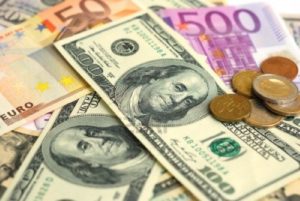 The euro advanced to the strongest level in more than two years against the US dollar on Friday, after European Central Bank President Mario Draghi signaled that deflation risks in the euro zone are easing, reducing bets ECB will add to monetary stimulus.
The euro advanced to the strongest level in more than two years against the US dollar on Friday, after European Central Bank President Mario Draghi signaled that deflation risks in the euro zone are easing, reducing bets ECB will add to monetary stimulus.
EUR/USD touched a 29-month high at 1.3915 at 11:30 GMT, after which the pair settled at 1.3878 on Friday, capping a fifth weekly advance of 0.55%. Support was likely to be received at March 6th low, 1.3722, while resistance was to be encountered at October 31st 2011 high, 1.4169.
Demand for the 18-nation common currency was supported after the Governing Council of the ECB maintained its benchmark interest rate at a record-low 0.25% at its meeting on Thursday. The Council also decided to keep the deposit rate at zero and the marginal lending rate at 0.75%. On the press conference, following ECBs interest rate decision the central bank President Mario Draghi said that deflation risks in the euro area are easing, boosting euros demand.
The ECB predicted that inflation will gradually accelerate. According to central bank’s estimates inflation in the euro area, which was at 0.8% last month, will accelerate to 1.7% in the fourth quarter of 2016. The cost of living will rise 1% this year, while it will accelerate to 1.3% in 2015 and an average 1.5% in 2015.
“It’s clear from what the ECB said yesterday that rates are on hold and they’re not going to take any more expansionary measures,” said Peter Kinsella, a foreign-exchange strategist at Commerzbank AG in London, cited by Bloomberg. “That, to me, says that the only thing that’s going to hold back the euro from here would be valuation concerns. I don’t see anything in the way of gains toward $1.40.”
Pressure on central bank’s officials to ease monetary policy waned after data revealed stronger inflation and economic output in the euro area.
In February, Eurostat reported that the inflation rate had rebounded from a 4-year low of 0.7% in October, which prompted the ECB to cut the main interest rate unexpectedly in November. Inflation in the euro area grew at an annualized rate of 0.8% in February, the same as in the previous month and exceeding analysts’ projections for a 0.7% increase.
At the same time, core consumer prices, which exclude volatile items such as food, energy, tobacco and alcohol increased at an annualized rate of 1% in February, exceeding experts’ forecasts for a 0.8% advance and up from January’s 0.8% increase. February’s reading was also the strongest since September.
While the recovery remains fragile, with inflation still remaining less than half the ECB target of 2%, which the central bank uses to define price stability, economic data in the past four weeks seemed encouraging. Gross domestic product in the 18-nation common currency area rose 0.3%, more than analysts had projected, mainly driven by stronger expansions in Germany, France, Netherlands and a return to growth in Italy. In addition, economic sentiment jumped to more than a 2-1/2-year high last month, while services and manufacturing output surged the most since June 2011.
The euro strengthened 6.4% during the past 12 months, the third best performer of 10 developed-nation currencies tracked by Bloomberg Correlation-Weighted Indexes, while the dollar fell 0.1%.
Meanwhile, the US Bureau of Labor Statistics reported on Friday that US employers managed to add 175 000 workers to payrolls in February, after a revised up 129 000 increase in the previous month. Analysts had expected a 149 000 advance in February. At the same time, the unemployment rate unexpectedly rose to 6.7% last month from a 5-year low of 6.6% as more Americans entered the workforce, but couldn’t find a job. The US added 194 000 jobs on average, each month last year.
The report suggested that US employers were upbeat about the economic outlook, after recent winter storms and much-below-normal temperatures across the US and especially across the eastern parts of the country, slowed consumer spending, housing and manufacturing.
“The fundamentals are good,” Joe LaVorgna, chief U.S. economist at Deutsche Bank Securities Inc. in New York, commented in a Bloomberg interview before the report. “Faster job growth means faster income and more discretionary spending. Ultimately, with more business spending, not only will they hire more people, they’ll hire more capital. Everything becomes self-reinforcing.”
At the same time, the deficit on United States’ trade balance widened insignificantly to reach 39.1 billion USD in January, after in December the deficit figure has been revised to 38.975 billion USD from 38.701 billion USD previously. Analysts had anticipated a deficit at the amount of 38.500 billion USD in January.
Factors behind this wider deficit have been the weaker fuel export and the increased import of oil. A larger trade deficit usually causes an adverse impact upon economic growth. Imports rose 0.6% to reach 231.6 billion USD in January, while overall export increased also by 0.6% to reach 192.5 billion USD during the same month.
In the week ahead investors’ attention will be focused on the US report on retail sales, scheduled for release on March 13th, and also on the report, encompassing producer prices in the United States, scheduled to be released on March 14th.
EUR/USD may be influenced by a number of reports/events, scheduled during the upcoming week as follows:
On Monday (March 10th), Federal Reserve President for Philadelphia Charles Plosser is expected to take a statement at 11:15 GMT. Meanwhile, the euro zone will release data on the investor confidence in March.
On Tuesday (March 11th), the largest euro zone economy, Germany will publish its trade balance for January, while Italy will release data on its GDP for the fourth quarter.
On Wednesday (March 12th), the euro area will release a report on its industrial production for January, while the US will publish data on its Federal Budget Balance.
On Thursday (March 13th), the Census Bureau in the United States is expected to release its report on retail sales in February, an indicator providing clues over the tendency in consumer spending in the country. This report will be accompanied by weekly data on the number of initial jobless claims in the United States, an indicator for lay-offs.
On Friday (March 14th), the United States is to release data, regarding producer prices in February, which serve as an early indication for the performance of the consumer price index in the country.
At 13:55 GMT Thomson Reuters in cooperation with the University of Michigan will announce the preliminary reading of their index of consumer confidence in the United States for March, which usually comes out two weeks ahead of the final data.





